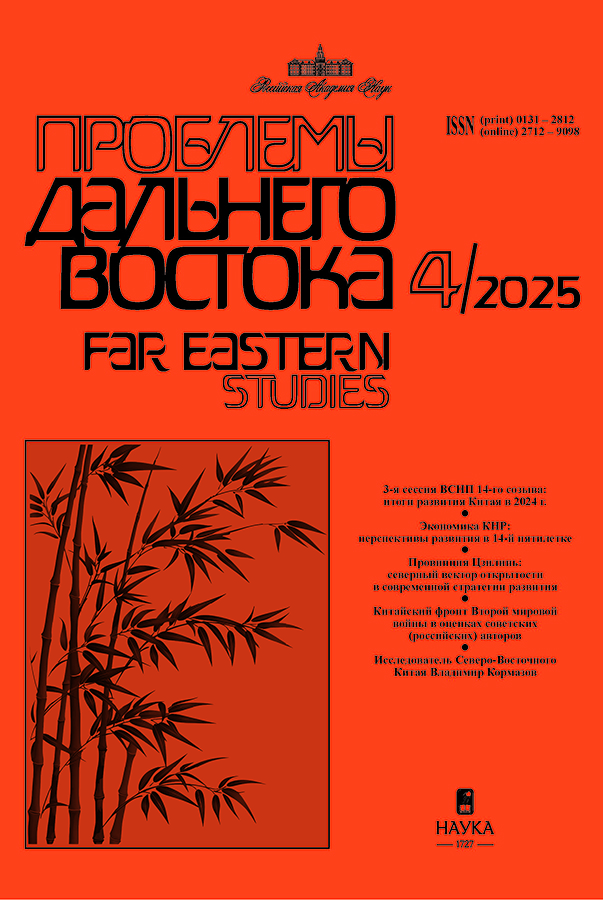Interests of China and India Regarding ASEAN: Rivalry or Parallel Courses?
- Authors: Bochkov D.A1
-
Affiliations:
- MGIMO-University under the Ministry of For- eign Affairs of Russia, RIAC
- Issue: No 1 (2024)
- Pages: 19-31
- Section: Politics
- URL: https://rjmseer.com/0131-2812/article/view/676371
- DOI: https://doi.org/10.31857/S0131281224010021
- ID: 676371
Cite item
Abstract
The paper examines whether the interests of China and India in relation to ASEAN reflect rivalry or rather co-exist in parallel without rigid confrontation. ASEAN occupies an important place among the key vectors of foreign policy of China and India in the Asia-Pacific region. ASEAN represents interest to China as an important trade and economic partner. The Associations is also important for China in regional security issues and the protection of the “first island line”. Strategically, deepening contacts with ASEAN is crucial for China in order to neutralize US plans to contain it. For India, the development of cooperation with ASEAN is aimed at balancing the strengthening of China's regional positions. Geopolitically, ASEAN is one of the key components of a “selfreliant foreign policy” of India, and enhances its role as a more active participant in key regional processes. New Delhi sees some potential for the development of joint transport, logistics and economic projects, and plans impetus to domestic economic development by strengthening trade relations with ASEAN. Despite the increasing rivalry between China and India for leadership in the region, Beijing and New Delhi are pursuing parallel courses with regard to ASEAN. ASEAN occupies an important place in the regional subsystem. Based on the concept of ASEAN-centricity, ASEAN plays one of the leading roles in the regional institutional architecture. Its members remain committed to a multi-vector approach and are interested in developing ties with all regional and non-regional actors, which help to uphold autonomy by maintaining foreign policy balance and benefit from multilateral economic cooperation.
Keywords
About the authors
D. A Bochkov
MGIMO-University under the Ministry of For- eign Affairs of Russia, RIAC
Author for correspondence.
Email: danilbochkov.a@gmail.com
ORCID iD: 0000-0002-7326-3966
Ph.D. Candidate, RIAC expert
Moscow, Russian FederationReferences
- Alok B. Study of International trade relation of India with ASEAN. Social Science Research Network.
- SSRN. 2021. doi: 10.2139/ssrn.3884883
- Banik N., Kim M. India—ASEAN Trade Relations: Examining the Trends and Identifying the Potential.
- Global Business Review. 2020. doi: 10.1177/0972150920953546
- Baruah D.M. Expanding India's Maritime Domain Awareness in the Indian Ocean. Asia Policy. Vol. 22.
- No. 1. 2016. Pp. 49–55. URL: https://www.jstor.org/stable/24905108 (accessed: 27.10.2023).
- Bochkov D.A. Kak kitajsko-indijskoe ekonomicheskoe sotrudnichestvo vliyaet na konfliktnyj potencial dvustoronnih otnoshenij? [How does Sino-Indian economic cooperation affect the conflict potential of bilateral relations?]. Mezhdunarodnaya zhizn'. 2023. No. 7. S. 28–45. (In Russ.)
- Butko A.A. Sostoyaniye i perspektivy razvitiya sporov vokrug ispol'zovaniya resursov reki Mekong [The state and prospects for the development of disputes surrounding the use of Mekong River resources]. Problemy Dal'nego Vostoka. 2023. No. 2. S. 93–104. doi: 10.31857/S013128120024926-9. (In Russ.)
- Denisov I.E. Koncepciya «Samodostatochnaya Indiya» i ee vozmozhnoe vliyanie na regional'nuyu bezopasnost' na prostranstve SHOS [“Self-sufficient India” and its possible impact on regional security in the SCO space]. Sotrudnichestvo Rossii i Kitaya v interesah obespecheniya bezopasnosti geopoliticheskoro prostranstva SHOS: problemy i perspektivy. 2021. S. 77–91. (In Russ.)
- Efremova K.A. ASEAN kak potencial'nyj sub"ekt global'nogo upravleniya: predposylki, vozmozhnosti i perspektivy [ASEAN as a potential subject of global governance: prerequisites, opportunities and prospects]. Polis. Politicheskie issledovaniya. 2020. No. 3. S. 44–55. doi: 10.17976/jpps/2020.03.04. (In Russ.)
- Kupriyanov A.V. Iniciativy SAGAR (Security and Growth for All in the Region) i IPOI (Indo-Pacific Oceans Initiative): formirovanie sfery bezopasnosti Indii cherez regional'noe razvitie [SAGAR (Security and Growth for all in the Region) and IPOI (Indo-Pacific Oceans Initiative) initiatives: shaping India's security sector through regional development]. Sravnitel'naya politika. 2021. No. 4. S. 68–81. doi: 10.24412/2221–3279–2021–10041. (In Russ.)
- Kupriyanov A.V. Indo-Tihookeanskij region: indijskij vzglyad [Indo-Pacific region: Indian perspective]. Mirovaya ekonomika i mezhdunarodnye otnosheniya. 2021. Vol. 65. No. 5. S. 49–58. doi: 10.20542/0131–2227–2021–65–5–49–58. (In Russ.)
- Majumdar S.K., Sarma A.P. E-commerce and digital connectivity: unleashing the potential for greater India—ASEAN integration. Journal of Asian Economic Integration. 2020. Vol. 2. No. 1. Pp. 62–81.
- Nachiappan K. India—ASEAN Relations: Riding and Transcending the “Indo-Pacific” Wave. The Journal of Indian and Asian Studies. 2021. Vol. 2. No. 2. doi: 10.1142/S2717541321400040
- Ogden C. India-ASEAN Relations: The Utility and Limits of a Norm-Based Approach. International Studies. 2023. Vol. 60. No. 2. Pp. 155–175. doi: 10.1177/00208817231162272
- Rajesh R. Evasive balancing: India's unviable Indo-Pacific strategy. International Affairs. 2020. Vol. 96. No. 1. Pp. 75–93. doi: 10.1093/ia/iiz224
- Ruan W.X., Yu X., Wang S.Y., Zhao T.C., Liu Y.Z. Exploration of China—ASEAN Trade Relations in the Context of Sustainable Economic Development—Based on the Lotka—Volterra Model». Sustainability. 2023. doi: 10.3390/su15010517
- Tang C., Rosland A., Yasmeen R. The comparison of bilateral trade between China and ASEAN, China and EU: From the aspect of trade structure, trade complementarity and Structural Gravity Model of Trade. Applied Economics. 2023. Pp. 1–13. doi: 10.1080/00036846.2023.2174940
- Xue G. Non-traditional security cooperation between China and South-East Asia: implications for IndoPacific geopolitics. International Affairs. 2020. Vol. 96. No. 1. Pp. 29–48. doi: 10.1093/ia/iiz225
- Yeo A., O'Hanlon M.E. Geostrategic Competition and Overseas Basing in East Asia and the First Island Chain. Brookings Institution. February 2023. 8 p. URL: https://www.brookings.edu/articles/geostrategic-competition-and-overseas-basing-in-east-asiaand-the-first-island-chain/ (accessed: 25.10.2023).
- 张洁: 东盟中心主义重构与中国-东盟关系的发展 [Zhang Jie. Reconstruction of ASEAN-centrism and development of China-ASEAN relations]. 2021年. 第3期. 第118–135页. (In Chin.)
- 杨悦: 东盟对中美竞争的认知与应对 [Yang Yue. ASEAN's understanding and response to competition between China and the United States]. 国际问题研究. 2021年. 第 4期. (In Chin.)
- 聂文娟: 东南亚地区中美战略均衡的机制论 [Nie Wenjuan. The theory of the mechanism of SinoAmerican strategic balance in Southeast Asia]. 国际政治科学. 2022年. 第1期. 第86–113页. (In Chin.)
- 钟飞腾: 中国周边安全环境: 分析框架, 指标体系与评估 [Zhong Feiteng. China's Peripheral Security: Analytical Framework, Indicators and Assessment]. 国际安全研究. 2013年. 第 4期. 第64–82页. (In Chin.)
Supplementary files











